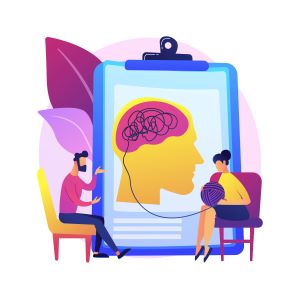And What to do About Them
How often have we gotten in our own way so to speak? You want to do something that you believe is important to you and that something doesn’t get started much less finished.
We often set up roadblocks to our success unintentionally. When it comes to being successful in therapy or self-guided therapy courses, there are quite a few beliefs that can can be a roadblock to successfully completing a program.
If we aren’t aware of the beliefs, we don’t recognize when we have encountered a roadblock. Unlike an actual roadblock, we don’t have signs that indicate the problems. Sometimes these roadblocks can end up costing us time and money as well as achievement.
Cognitive Emotive Dissonance
This is the top roadblock and I have seen it derail therapy progress. Best way to describe this is with an experiment. For this, you will need a pen and a piece of paper. On the paper, write your name with your dominant hand. By the time you are an adult you have signed and printed your name 1000’s of times and as such it is completely second nature.
Now put the pen in your nondominant hand. Now with this pen in the nondominant hand, print your name. For the majority of us, I bet that didn’t go as smoothly.
How did that feel physically writing with your nondominant hand as compared with your dominant hand? The first time you didn’t have to think about it, the writing was natural. The second time, you likely had to figure out how to make the hand move in a different way then was natural for it, had to think about forming letters and making the letters recognizable.
How did it feel emotionally writing with your nondominant hand? With your dominant hand, likely you didn’t have much in the way of an emotional response. With the nondominant hand, there is a greater likelihood that you had a stronger and negative emotion.
Cognitive emotive dissonance is that weird and strange feeling that you get when trying something new especially if the new way is different than how you tended to believe. Is there anything particularly wrong with using either hand to write? No. Let’s say that you had to learn to use your nondominant hand, I bet over time using practice and patience you would develop proficiency.
As a kid I remember a time that my grandfather injured his shoulder and upper right arm so badly that he required surgery. He couldn’t use his right arm. He was an artist so while recovering at home he wanted to draw and paint. He struggled at first but he eventually became proficient enough that the quality of the art wasn’t impacted.
Cognitive emotive dissonance is a problem in therapy and self-guided courses because in order to change the way that someone feels, thinks and does, requires a change in the way we think, feel and do. These changes most often feel strange and different and that uncomfortable feeling can prompt us to think that what we are doing is “wrong.” It isn’t wrong, it is only different.
Imagine a trip to London in which you will be required to drive. In England the car steering wheel and traffic flow is opposite than what we are accustomed to in the United States. If you refuse to change from your American style of driving, you won’t go far on the streets of London.
The solution for cognitive emotive dissonance is to recognize first if you are feeling strange, weird or uncomfortable as you are considering therapy, courses or already engaged in therapy. That weirdness feeling is the due to the “newness” of the activity.
Then remind yourself just like learning to drive in Europe, you learned to drive in America with practice and patience, you will learn to drive in Europe again with practice and patience. Same with therapy or courses. As you first start it is going to be weird and different, but there is nothing wrong about this new way – just different. And different in the case of changing negative emotional states is not only advantageous but imperative. Different doesn’t mean wrong, just means that this new way hasn’t been practiced. the more you practice, the less weird it feels.
Symptom Stress
This was first discussed by the father of Cognitive Behavioral Therapy, Albert Ellis. He described it as being upset about being upset. It can be that someone gets mad about being sad. Or anxious about being angry. Anxious about being anxious. It is the case that when we feel a negative emotion, we have a new negative emotion about the first. Aldo Pucci, my teacher and creator of Rational Living Therapy also refers to this as symptom distress.
Some examples are:
- Being depressed about being depressed
- Being anxious about being depressed
- Being depressed about being anxious
- Being anxious about being anxious
- Being afraid that you are going insane
- Being afraid about having a nervous breakdown
- Being afriad of losing your mind
- Being afraid that you will have to be hospitalized
- Being afraid that you will always have this problem
- Putting yourself down for not resolving this problem
- Putting yourself down for being the only person with this problem (Pucci, 2006)
Basically there are three problems in self-improvement with symptom stress. The first issue is the amount of energy that symptoms stress takes. First we have the original upset and then we have more energy spent of being upset about that upset. That takes a lot of energy so much so that often we don’t have the energy to resolve the actual problem.
The second problem with symptom stress is confusing which problem we think we need to fix. We may seek therapy for being so angry only to find that we are still getting unreasonably angry only to learn that the actual problem is anxiousness. Without fixing the actual issue, we often continue to upset ourselves about being upset. Sometimes people forget the original reason that they were upset about as they exerted so much energy with the second emotion.
Rebecca came to me after the birth of her son. She was very depressed and thought she had post partum depression. She loved her baby and bonded to her baby just fine so it wasn’t an issues with post partum. She was so upset that she was going to hurt her baby and that she felt so helpless to prevent it. The sadness was symptom stress over fear of harming her baby. Her family was quite abusive and she was fearful that would be her fate as a mother. If we would’ve only treated the sadness and hopelessness, we wouldn’t have realized the fear which was the issue that needed to be addressed. Once the fear was addressed, the symptoms stress disappeared.
The last problem with symptom stress is a lack of belief in our own ability to cope. This is a case of “can’t standitis”. First we become upset over something and then believe that we cannot stand or tolerate feeling this upset. This often leads to the belief that we have to change how we feel and we have to do so right now! This leads to some very dysfunctional ways to remedy ourselves of the upset from spending money, engaging in risky sexual encounters, using drugs and alcohol or binge eating.
Can’t Standitis and the Truth about our Brain
The solution to can’t standitis is to understand that what we can’t actually stand are those things that kill us. We couldn’t stand an airplane falling out of the sky on top of us. However we can stand a negative emotion even a really big emotion because it won’t kill us.
There are three facts about the brain that are critical.
- Human brain is capable of thinking anything
- The human body (when properly working) is the home of the sensations we call emotions
- Our brain can discern when we are lying to ourselves, telling a joke and being sincere
The human brain is amazing in the complexities. These thinking brains put a man on the moon and powerful computers in the palm of our hands. And this same brain will allow us to think irrational thoughts without any consideration if those thoughts are accurate, lead to feeling the way that we want or even useful for us in anyway. Our brain will allow us to think anything without concern of accurateness to facts.
The human body is where the emotions are experienced. If our brain is having a depressive thought, our body is going to produce all the hormones, body changes and sensations to experience depressed feelings in our body. How do you know when you are angry? What does that feel like in your body? How is that different from anxiousness or sadness? The sensations are different depending upon the emotion and the emotion is dependent upon our thinking.
Our brain discerns jokes, lies and sincere statements prior to the body sensations. If someone says, “oh I can’t stand it when my partner forgets to lock the house,” but they are lying or joking, then there isn’t going to be a significant emotional reaction. When we sincerely belief that we cannot stand something, the brain will direct the body to feel that strongly and then we act on that strong feeling (and not usually in ways that help us).
A statement about the partner forgetting to lock up may end in an argument or doing something to change the negative emotional state. The speaker’s brain allows any thought, it is believed sincerely without concern for accuracy and then the body is engaged. If the speaker’s reaction is very upset, they are certainly equating life or death to the situation.
This is often the dynamic that continues substance abuse. Philip was going through a bad spot in his marriage. His wife said that she was attracted to another man and Philip was devastated. He came into therapy saying how he couldn’t stand that she was with another man and to cope he drank heavily, engaged in drunk texts begging her to stay and was very sad. Once he began to understand that his reactions were like that of a man being deprived life vs losing a relationship, he was able to begin to address the issues in the relationship and his excessive drinking.
Solution to Symptom Stress
First and foremost recognize that negative emotions are uncomfortable. No one is likely over the moon so to speak about feeling negatively, but it isn’t a matter of life or death. When we realize that we might not like feeling negatively, but that it isn’t going to be the end of us, it can go a long ways to reducing symptom stress. We may very much dislike feeling negatively but we can stand it.
Final notes when it comes to some of the ideas of symptoms stress. With fear of “losing your mind” or having a “nervous breakdown,” it is impossible to lose our minds. Whenever I think of this I imagine what a camera would show if it were to take a picture of a lost mind or a broken nervous system. That can be quite funny. These are phrases that thankfully aren’t true. No one loses their minds or has nervous breakdowns literally or figuratively. In a normal healthy brain not affected by diseases such as schizophrenia, the brain pumps out the thoughts that the body experiences as emotions and so we cannot lose control. We learn to control what in eastern philosophy is called the monkey mind we resolve the emotional upheavals.
These are only two barriers that often lead to lack of progress in therapy. To learn more about the other roadblocks, you can learn more from a free course here:
If you want to learn about trauma and the brain, click here to watch my free online webinar.
 Skip to content
Skip to content


